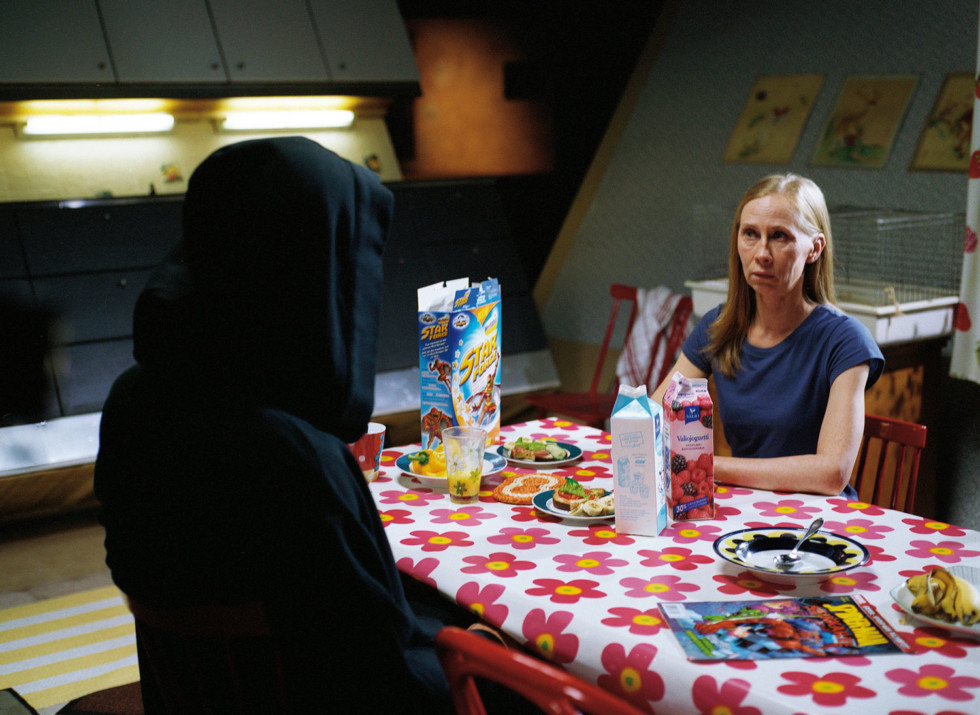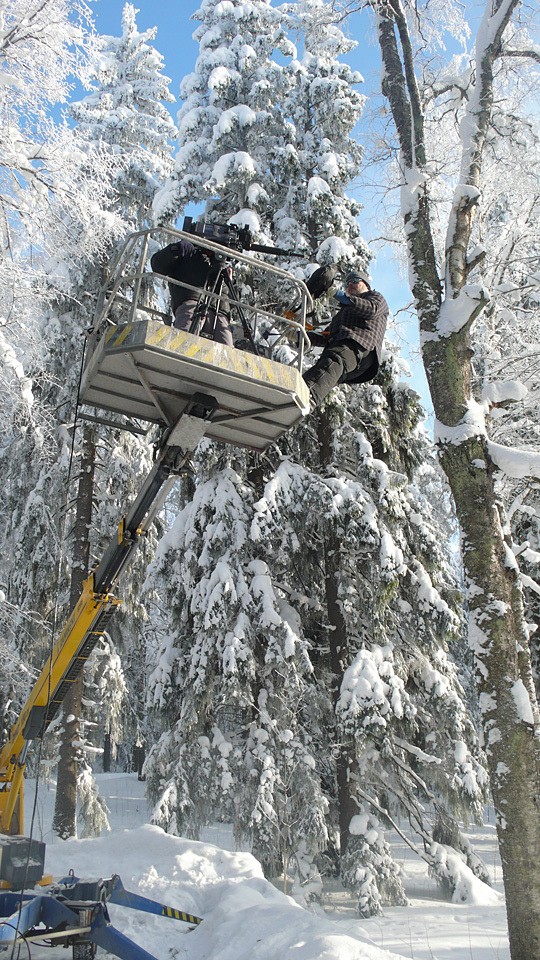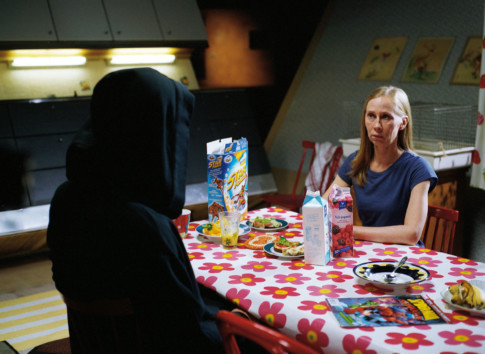
Eija-Liisa Ahtila, Where Is Where?, 2008 © Eija-Liisa Athila/BUS 2012/Crystal Eye Ltd, Helsinki. Courtesy of Marian Goodman Gallery, New York and Paris. Photographed by Marja-Leena Hukkanen
A conversation: What is the first image?
Lena Essling: Let’s begin with Horizontal (2011), which is currently in production. It seems to be about limits – not only those of human perception but also those of the camera as an extension of your body and of your senses and the ways of overcoming that.
Eija-Liisa Ahtil: A Horizontal is a portrait of a spruce tree. We shot a tall tree in six parts, which will be presented with six projections on a wall in a gallery, not vertically but horizontally, one next to the other, so that the viewer will see a long tree covering one wall of the space. Kind of six “portrait format” projections forming the horizontal tree.
As well as a portrait, it’s really about the moving image – about film and the tradition of showing things through the lens, about a way of recreating our reality and the world around us through the cinematic way of perceiving and the mechanics of film. Film is a medium for understanding and putting things in a certain order. It gives us the illusion of being a limitless medium and the only means of recording transparently, without altering the object. It can be easily thought of as a kind of electronic or digital window that brings the world to us without changing it, as if there were no human being behind the camera, making decisions, or as if it was a medium specially created as an extension to our anatomy.
I want to somehow make visible the limits, or edges, of human perception and to try to show the idea introduced by Jakob von Uexküll – of the simultaneous existence of different worlds, different times and spaces.
The cinematic device has this trust built around it, yet it can’t read all kinds of worlds and show them to us. I try to show that the worlds of, for example, nature and specifically human cinematic expression don’t meet. There is discrepancy so that, even if they do exist in this world together, they are parallel.

The recent drawing project – Anthropomorphic Exercises on Film, 2011
Lena Essling: The recent drawing project – Anthropomorphic Exercises on Film (2011) – how does that relate to the video work?
Eija-Liisa Ahtila: First, I had this need to draw, to make drawings, but I was still working on The Annunciation (2010). For the beginning sequence of that, I drew a little spruce and then, when we made the film version with three images, we needed another one.
When we were shooting the forest scenes for The Annunciation, our plan was to first shoot the landscapes and then the trees. Soon, it became clear how difficult it is to really portray a tall tree because of the size of the film image – its aspect ratio.
After finishing the film, I started to work with the series of drawings which I then named Anthropomorphic Exercises on Film. The starting point was the two small drawings I had made for the film. With the drawings, I thought about describing the rules and conventions of film-making – like the aspect ratio, how you shoot and edit a conversation, how you create a character and so on. What would happen to those rules if the protagonist was not a human?
Let’s take as an example the action. If drama has been based on action since Aristotle and Poetics, and if the action takes the story forward and shows the world and us in it, then, if the protagonist is not human, what will we see? What will the collision be like?
Again let’s take as an example the drawing called Aspect Ratio, which has a similar approach to Horizontal but is done in another medium – with the frames of the piece of paper acting as frames of the moving image. In the first image, you’ll see the top part of the spruce. And then, in the next one, you’ll see the bottom part. In the third one, you’ll see the same spruce, kind of kneeling. But the top is still missing. Then, in the last one, you’ll see the spruce kneeling plus bending its “head,” and only then does it fit within the frame of the paper. It’s about incommensurability between the world of film and that of spruces.
Lena Essling: They sound close to Uexküll’s own scientific illustrations or your own storyboards when preparing for a work.
I am thinking of a quotation from The Annunciation: “How does one know what things are, unless they’re already familiar?” With your choice of subject matter, or protagonist even –the spruce in Horizontal – it seems as if you are taking something familiar and making it foreign, abstract and strange.
Eija-Liisa Ahtila: Yes, that’s nicely put. That’s in fact something that I feel is happening to myself. The more I work as an artist, the more I find things that I don’t really understand – or maybe a better word would be recognise – and I think that that, in itself, is a crucial thing. Maybe I’m going too far now, but I believe that it also has to do with the idea of knowledge. Knowing something is actually more like standing by or co-existing, finding the possible relation with the other and your place to stand.
Lena Essling: So you could try to get in tune with things, but you cannot grasp them completely; you can’t own them by studying or describing them. Uexküll describes the studies of different species as “excursions into unknowable worlds.” This could work equally well as the title of a novel by Jules Verne or of this exhibition.
Eija-Liisa Ahtila: It has been extremely important to come across Uexküll’s texts. I had been interested in animals, nature and their relation to humans, but finding out about him, and then the question of the animal and posthumanism, has been very helpful – kind of a relief from the feeling of isolation, and a realisation that posthumanism is, in fact, a topic that is very important in philosophy, the arts and ongoing cultural discussions. It’s funny, in a way, that it’s so difficult to recognise at first and that it can then concretely change what is visible for you.
Lena Essling: It’s almost like getting an understanding of a language. Your choice of subject is interesting in another sense – the spruce is so familiar, a Nordic cliché almost, which appears in several of your earlier works.
Eija-Liisa Ahtila: Often, in Finland, the spruce is seen as less important among other trees – both as a building material and as a part of the visual surroundings.
I am frankly afraid that people will not recognise anything when they look at the drawings. If you don’t see it, it’s empty and makes you frustrated, as is often the case with short film and narration. Breaking radically with traditional narration makes it challenging for viewers to get involved, sometimes to the point where it just doesn’t happen.That familiarity of the spruce, what is it really – what’s familiar about it? We have defined it and we are used to it. When was the last time – if ever – that we thought about what the relationship between us and, for example, a spruce, could be? Considering this ecological situation, we need these naïve questions – questions that cannot be answered in a second, questions that are not meant to be answered, but rather are left hanging to open up something unfamiliar.
I’ll give an example: there are a few groups of people here in Finland, who are making physical or experimental theatre without any traditional notion of drama – or with a very altered one. One of them did a production for dogs. I can’t really describe it adequately, but I want to mention a detail of it as an example: A part of the “play” was set in a forest area in Helsinki and there was this character whose role – if you can say that – was that she crawled a straight line of one kilometre in the forest.
When you try to change the point of view of us humans to something else, you have to change the language – this is also the case for film – and then, perhaps it will not speak to the audience or they will feel left out.
If you want to tell a story differently, without the limitations of classical dramatic action, what is left? What will people see? If you are not working with that kind of narration, it’s difficult because it’s everywhere in film – in the editing, the shooting, the acting and in the building of the character. You can’t then simply talk about, for example, good or bad acting – from which point of view?
With The Annunciation, sometimes I think that it doesn’t work at all. At the Venice Film Festival, I saw it just after having watched twentythree features that were all about traditional dramatic action. And, after seeing it, I felt – there’s nothing. But then, seeing it again, especially the installation but also the one screen version, I was really happy about the atmosphere.
Lena Essling: What do you think about, let’s say, Structural film of the 1960s trying to break completely with the use of plot and storyline?
Eija-Liisa Ahtila: They are very interesting, beautiful and important films, but that’s not what I aim to do. In a sense, it’s easier because it’s abstract experimentation. This is too big a question to be talked about here, but in brief – we know what abstract is or what it is supposed to be. And I don’t want to leave narrative or acting behind. But then I have to ask: “What is a narrative? What can it be?”
I am also interested in Hans-Thies Lehmann’s ideas about post-dramatic theatre. Could there be something like post-dramatic film? Meaning that there would still be performing, characters, story elements and some kind of story told in a certain time.
Lena Essling: In some works, you use very recognisable, classical dramatic elements, like a Greek chorus or a Brechtian verfremdungseffekt. But The Annunciation explores other things as well. On a certain level, it is really not so concerned with the biblical story, but rather with Renaissance painting and the development of perspective, as well as their use of colour and light. Also the question of how to “translate” perspective into a temporal, time-based medium – would you agree with that?
Eija-Liisa Ahtila: Yes, it’s really about images – still images turned into moving ones and moving material adapting the qualities of paintings. When I started to make the piece, I didn’t know that the Annunciation paintings of the Renaissance era were done at a time when perspective found its way into painting. Before Giotto and Fra Angelico, let’s say, when they didn’t use central perspective, the valuing of things in a painting was quite different. Perspective brought with it a new hierarchy and a new system for giving information.
The cinematic way of narrating creates a position for the viewer in which he or she can follow the story and everything is served up. A certain world is created and the information is presented in the way that the director decides. If you have a complex, multi-screen situation, however, that doesn’t happen. Of course it’s edited, but for multiple screens. The fact that there are many screens and they may also be positioned around the viewer breaks the idea of central perspective. It also emphasises the position of the viewer, concretely in the space as well as in relation to narration. It is interesting to see where 3D technology is going and what it will offer from the point of view of experimental film.
Lena Essling: You have said that film always has a point of view but that painting does not.
Eija-Liisa Ahtila: I mean the characters in the paintings. When I was planning The Annunciation, I needed to transform the ideas in the paintings into the language of moving image. There was the space, the actors, and then I had to think about how to tell the story of the angel coming to greet Mary, employing the language of the movie. So, when do we see the angel? And where? And how?
Lena Essling: Bringing it to a very concrete level.
Eija-Liisa Ahtila: Yes, exactly. What is the first image? But also: “When does Mary see the angel?” and “What does Mary see?” In the paintings, Mary’s point of view is not such an important question, neither in regard to how the event is shown nor as a woman’s point of view. The paintings are created for the viewer witnessing the paintings.
The question of what Mary sees is a question of point of view and very relevant within film. The only painting I could recall that includes the character’s point of view was Diego Velázquez’s Las Meninas, in which the viewer is standing where the king and queen are implied to stand, so that our point of view is, in fact, theirs. For the film, I had to include Mary’s point of view – how she sees the angel and what is in fact the miracle.
Making The Annunciation was really an educational process for me. In the very beginning, I wrote in my notes that the most important thing when making it would be to keep things open for as long as possible – not to fix them. Of course, this also had to do with the cast.
I wrote the script, but it was not used in the usual way. For example, in Where is Where? (2008), there are these long poems that I wrote, as Kati Outinen is a professional actor who could learn them. With an amateur cast, it would have made no sense to hide the spontaneous dialogue. The script was more like a structure and there was this constant movement between the script and things that just happened on set. They all maintained and expressed their own ideas about the biblical events. Kati’s character, the director, led the dialogue and kept to the lines written for her, so that the information that I felt was necessary would be included.

The Annunciation, 2010

